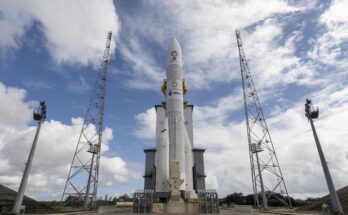by Bill Ostrove, Space Systems Analyst, Forecast International.

Two years ago, Forecast International published a blog post about a trend toward decreasing launch mass in commercial communications satellites. Since that post has remained popular, we think our readers will be interested in an updated look at trends in launch mass and the commercial satellite industry.
During the past five years, satellite size – measured by launch mass – has fluctuated, making the overall trend more complex than it first appeared in 2015.
Throughout the first decade of the 2000s, satellites had steadily increased in size. Larger satellites are able to support more equipment that can provide service to larger numbers of customers. The larger size also enabled launch efficiencies, as multiple smaller satellites would necessitate more launches.
Average launch mass reached a high of 4,293 kilograms in 2012, and then began to decline – to 3,201 kilograms in 2013, and then to 2,494 kilograms in 2014 – before increasingly slightly to 2,525 kilograms in 2015. Then, in 2016, average launch mass jumped again, to a new high of 4,982 kilograms. The spike in 2016 was mostly the result of there having been no satellites launched to LEO (low Earth orbit) that year. (LEO satellites are typically smaller and lighter than GEOs – satellites launched to geosynchronous Earth orbit.)
Over the past five years, the trend in launch mass of GEO satellites has been generally upwards, reaching 5,313 kilograms in 2013, declining to 4,374 kilograms in 2014, and then rising slightly in 2015, to 4,597 kilograms. GEO satellite launch mass increased again in 2016 to 4,982 kilograms.
The increase in GEO satellite launch mass is largely due to the launch of multiple heavy high throughput satellites (HTS), such as EUTELSAT 65 West A and EchoStar XIX. In fact, going forward, HTS systems could continue to drive up average launch mass.
In addition, the Ariane 5 remains a powerful influence in the market, and a return to reliability of the Proton could further improve the market and lower the cost for heavy launch services.
Nonetheless, the overall trend over the past few years has been for satellites to get gradually lighter. The decline in launch mass can be attributed to a number of factors. Smaller regional satellite operators, which are rising in importance in the market, tend to purchase smaller satellites, since they are cheaper.
In addition, cheaper launch vehicles like the Falcon 9 are increasing the appeal of relatively small satellites. Previously, satellite operators relied on the Ariane 5 and Proton to carry spacecraft into orbit. Use of these large and expensive rockets encouraged the launch of larger satellites (as opposed to many smaller satellites) because cost factors favored fewer flights. However, when cheaper launch vehicles like the Falcon 9 are used, more frequent launches of smaller satellites become affordable and efficient.
Technology advancements are also making small satellites more appealing. For example, in 2015, Asia Broadcast Satellite and Eutelsat launched two satellites that use all-electric propulsion. This technology reduces the need for large stores of propellant and reduces launch mass. As these all-electric propulsion satellites become more popular, the trend toward smaller satellites will likely continue.
With the increasing popularity of smallsats, many satellite manufacturers that traditionally specialized in large spacecraft platforms are broadening their product lineup to include smaller satellites. Boeing is one example of this trend. A few years ago, it introduced its Boeing 702SP platform, a smaller, more cost-effective variant of its 702 platform.
Going forward, smaller satellites will remain popular and may grow in popularity as new companies enter the market to take advantage of advances in technology. LeoSat and OneWeb plan to build networks of small satellites that will provide broadband data services around the world. If such companies are successful, we should expect to see launches of hundreds of small satellites.
 For more information on the trends in the commercial communications satellite market, check out Forecast International’s analysis: “The Market for Commercial Communications Satellites.”
For more information on the trends in the commercial communications satellite market, check out Forecast International’s analysis: “The Market for Commercial Communications Satellites.”
A military history enthusiast, Richard began at Forecast International as editor of the World Weapons Weekly newsletter. As the Internet grew in importance as a research tool, he helped design the company's Forecast Intelligence Center and currently coordinates the EMarket Alert newsletters for clients. Richard also manages social media efforts, including two new blogs: Defense & Security Monitor, covering defense systems and international issues, and Flight Plan, which focuses on commercial aviation and space systems. For over 30 years, Richard has authored the Defense & Aerospace Companies, Volume I (North America) and Volume II (International) services. The two books provide detailed data on major aerospace and defense contractors. He also edits the International Contractors service, a database that tracks all the contractors involved in the programs covered in the FI library. More recently he was appointed Manager, Information Services Group (ISG), a new unit that encompasses developing outbound content for both Forecast International and Military Periscope.




